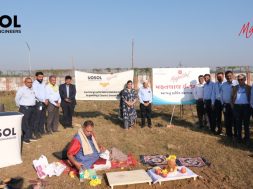
JA Solar Bifacial Double-glass Modules Increases Energy Yield by 23% in Comparison Test Conducted by TÜV Rheinland
With its advantages in increasing energy yield and decreasing LCOE, bifacial double-glass module has become the mainstream product used in large-scale ground-mounted PV power plants. Leading the industry in the development and application of bifacial double-glass modules, JA Solar began mass production of the PERC bifacial double-glass modules in 2017. Since then, it has supplied modules for a number of large-scale PV power projects around the world, including the world’s first large-scale bifacial double-glass modules PV project. The company integrates bifacial double-glass structure with multiple advanced technologies including MBB, half-cell technology, large-size wafers and gallium-doped wafers to continuously improve the power generation performance of the product.
To assess the performance of JA Solar bifacial double-glass modules in practical application, JA Solar jointly conducted an energy yield test with TÜV Rheinland in a state-owned 100MW PV power plant in Delingha, Qinghai. The objective was to compare the power generation performance of bifacial double-glass module (JA Solar) and mono-facial mono modules connected with different types of inverters and racks, in an effort to provide reference points for downstream customers in module selection. The result of the test shows that, compared with mono-facial mono modules, the JA Solar bifacial double-glass modules significantly increase power generation.
To avoid the influence of export limitation, 4 unlimited arrays were chosen as samples. The 4 arrays are No.1 array with JA Solar bifacial double-glass module, and No. 23 array, No.33 array, No.44 array installed with mono-facial mono modules from different module manufacturers. Detailed information about the arrays is summarized below.
| Array | No.1 | No.23 | No.33 | No.44 |
| Module type | Bifacial double-glass 310W(JA Solar) | Mono-facial mono 310W(Different module manufacturer) | Mono-facial mono 310W(Different module manufacturer) | Mono-facial mono 310W(Different module manufacturer) |
| Rack type | Horizontal uniaxial rack(2P,Height:2m) | Fixed adjustable tilt angle(15°/37°/55°) | Fixed tilt angle(37°) | |
| Inverter type | String Inverter | Distributed inverter | Centralized Inverter | String Inverter |
| Notes: The arrays are neighboring and built on the same land type, designed and constructed by the same construction team with the same construction cycle and grid-connected time. The selected are all export-unlimited arrays. | ||||
The sample data is from June 6, 2019 to October 19, 2020. After contrasting, cleaning, screening and deleting abnormal data, the data of a total of 485 days is qualified. To ensure the objectivity of data comparison, TÜV Rheinland conducted consistency tests on the performance and quality of modules. The result shows that the power generation performance of both bifacial and mono-facial modules is consistent with their performance in the same period in 2019. Additionally, no significant differences were observed in the quality consistency test including I-V curve measurement, thermography inspection (IR), on-site electro luminescence imaging (EL), and dust loss test.
According to the analysis results of TÜV Rheinland, taking into account the influence of the tracking bracket, the energy yield of No.1 array with JA Solar bifacial double-glass modules is 15.44%, 23.34% and 20.25% higher compared with No.23, No.33, No.44 respectively. This demonstrates the excellent power generation performance of JA Solar bifacial double-glass modules in the system part.

JA Solar’s bifacial double-glass modules have been widely used in PV projects across the globe. The result of the test once again validates the excellent power generation performance of JA Solar bifacial double-glass module, enabling it to become a good choice to guarantee ROI for downstream customers. With the integration of bifacial double-glass structure with more high-efficiency technologies, JA Solar continues to improve the performance of its bifacial double-glass products to decrease LCOE, and optimize the advantages such as low attenuation and long service life to bring more benefits to customers.













